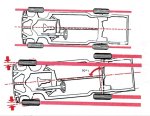I was just quoting from the manual (bolded part).
Unless I'm misunderstanding it, they are expecting that you understand that dog tracking is crab-like behavior and it (truck) should -not- be dog tracking.
Rather than dog tracking being the fact the fronts and rears have different track. I don't know if that's called a stagger, usually I hear that in relation to tires, but it's just a difference in track for design purposes.
If the amount of track difference left/right isn't the same then you get dog tracking.
It really goes back to what do dog tracks look like in the snow? Are the fronts always to one side of the rears, or, is it that the fronts are always wider than the rears? I dunno and have no snow to test right now.
But you can Google it, and it looks to me like the rears are inside the fronts.
Now do you ever see a dog running with their whole body slanted sideways (crab-like)? I don't think so, it's something you'd right away go, wait, something is wrong with this dog. Or maybe you do see it and I just never noticed. To me it would imply the rear tracks of the dog don't line up with the front - maybe it's true.
You don't check it on a crowned road they are just saying you might notice it (front left height higher because it's further up the crown) but really I doubt you'd see it. Roads are all crowned or else water pools in the middle. Some are severely crowned. That's life, and depending on the vehicle you can get pull to the right (downhill) because of gravity. If it's noticeable, you can adjust the front toe-in so the car tracks straight on an "average" crown (mild) but if it's on a total flat it will pull slightly to the left, of course. Long ago, I've done this. But I'd say it's probably not recommended. Front wheel -may- be affected more in this way (it was front wheel drive).
Like, let's say you're driving along, they some guy says, hey, do you realize your truck is dog tracking? And you go, no, it's just the crowned road makes it -look- like that to you, but I checked it, and it's in spec.
The truck in question ('97) drives great, it doesn't pull to either side at any time, or wander, that I see, either under constant throttle, acceleration, or braking (kind of one of those things you test when you're looking at one, right?). So I don't have an issue, at least not known, and all tires seem to wear normally and evenly. But if I had alignment checked, which no doubt I will at some time, I'd ask them, what's the spec you are using and how does it compare to factory spec. Obviously they are doing to have different specs for different vehicles so I would expect it to match the factory spec.
How you would change the track either front/rear who knows, probably you would be adjusting the front, but it probably means moving major things relative to the frame.
So here's what the manual says. I think they just expect that you just know, dog tracking, it's bad (because... I dunno... it looks weird? drives weird?), you don't want it. Note they say on a crowned road it may appear (!) to dog track but my take is they're just warning you, this doesn't mean it's dog tracking (out-of-spec) it just appears that way, but here's how you check it.
oh and I have I re-correct myself my track should be 1.5" narrower on each side so 3" total. (Dana 35). The truck is straight along the side that's why you see the rears quite far inside the fenders, front, not so. They didn't make any attempt to hide it in the body shape, on this vehicle.
It's the second column of the last pic where they talk about how to measure it. "when you notice the vehicle dogtracking" - um... how do you notice this? the body is crooked relative to your straight line, is how I take it.















